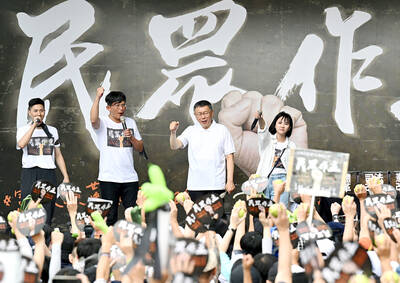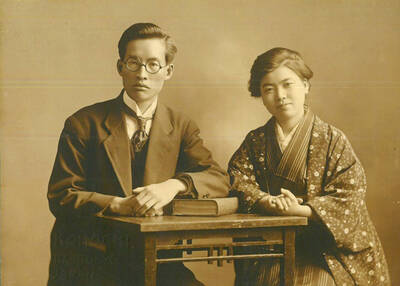Harmony and Integrity — The Yongzheng Emperor and His Times (雍正─清世宗文物大展), which opened last week at the National Palace Museum (故宮博物院), has received particular attention as the first plank in an extensive cooperation agreement between the museum and the Palace Museum (故宮博物院) in Beijing.
Thirty-seven items are on loan from Beijing, along with a couple of contributions each from the Shanghai Museum (上海博物館), Academia Sinica (中央研究院) and the private collection of UC Pharmaceuticals (五洲製藥股份有限公司), making this the most comprehensive exhibition ever on the life and times of the Yongzheng Emperor (雍正), a shadowy but crucial figure in the consolidation of the Manchu Qing Dynasty’s domination over China. (The rest of the 246 pieces on display come from the National Palace Museum’s permanent collection.)
Putting aside the gratifying achievement of inter-museum cooperation, which will also include a host of scholarly exchanges, the exhibition itself is not much of a departure for the museum. While some of the items are splendid to look at, the nature of the exhibition is still very much research driven, with an unduly high proportion of objects that might excite scholars but are unlikely to wow the general public at first glance. This may be partly remedied by the audio tours, thematic tours, educational activities and training tours for elementary and high school teachers.
Yongzheng, who reigned for just 13 years (1722 to 1735), came to the throne after a bitter succession struggle in which he proved utterly ruthless toward anyone who got in his way, including many of his siblings. Despite the peace and prosperity that he brought to his realm through efficient administration, building on the foundations of his father the Kangxi Emperor (康熙), this legacy of brutality and the suspicion of an illegitimate succession have tainted his name. The fact that his reign was sandwiched between two of the Qing Dynasty’s most able and long-reigning emperors — his father was on the throne for 61 years and his son Qianlong (乾隆) for 60 years — further places him in the shadows. This exhibition is intended to go some way toward clearing his name, presenting him as an individual and revealing the artistic flourishing over which he presided. It achieves this enormous task with considerable success, though given its huge scope, it is easy for visitors to lose the thread.
One of the key items in the show is The Kangxi Emperor’s Last Will and Testament (康熙遺詔), one of a small number of items on loan from the Collection of the Institute of History and Philology, Academia Sinica, which supports Yongzhen’s legitimate claim to the throne. The relevant text is highlighted in the display case. While doubtless of inestimable value as a piece of historical evidence in a complex scholarly debate, for the casual visitor, there is insufficient context to excite much interest.
The many-layered facade of imperial court life makes getting to know someone like the Yongzhen Emperor enormously difficult, something that is highlighted above all else by the two larger-than-life formal portraits of him, one sitting, one standing, both showing in painstaking detail the intricate imperial garb and impassive features of the emperor. Other works such as a massive 468.7cm-long scroll of the Yongzheng Emperor making offerings at the altar of the god of agriculture chronicle the infinitely complex court ceremonial practices of which Yongzheng was the center.
In vivid contrast to this highly formal material, there are a number of letters and other official documents on which the emperor has added his own pithy comments in vermilion ink, revealing a sharp, opinionated bureaucrat with a deep concern for those working under him. There are moments when his words sound remarkably contemporary, and this, above all, brings him vibrantly alive.
This official face is contrasted with pictures of and items taken from everyday court life. Beauties: Appreciating Antiquities (美人圖:鑒古) from the Palace Museum, Beijing, is a treasure trove of detail concerning the decorative features of the court’s inner apartments, from the costumes of the imperial consorts to the furnishings and decorative knickknacks that were favored at the time. There are a couple of works by the Jesuit missionary Giuseppe Castiglione, who was resident at the imperial court around this time, most notably of horses, and other works by court painters that reflect the adoption of Western techniques, an indication of Yongzhen’s broad-ranging artistic tastes, and hint at the looming storm of European involvement in Asia.
The exhibition touches on many aspects of life during Yongzheng’s reign, and presents a lovely panorama, although it can feel somewhat unfocused at times as it reaches for inclusiveness at the expense of clarity. The historical notes in English posted on the walls can be maddeningly vague, and individual explanatory labels are rather too minimalist to be helpful in explaining the significance of specific objects on display. There is, nevertheless, plenty there for those with the time and interest to pull it all together — it would just have been nice if the curators could have been a bit more helpful.

In the next few months tough decisions will need to be made by the Taiwan People’s Party (TPP) and their pan-blue allies in the Chinese Nationalist Party (KMT). It will reveal just how real their alliance is with actual power at stake. Party founder Ko Wen-je (柯文哲) faced these tough questions, which we explored in part one of this series, “Ko Wen-je, the KMT’s prickly ally,” (Aug. 16, page 12). Ko was open to cooperation, but on his terms. He openly fretted about being “swallowed up” by the KMT, and was keenly aware of the experience of the People’s First Party

Aug. 25 to Aug. 31 Although Mr. Lin (林) had been married to his Japanese wife for a decade, their union was never legally recognized — and even their daughter was officially deemed illegitimate. During the first half of Japanese rule in Taiwan, only marriages between Japanese men and Taiwanese women were valid, unless the Taiwanese husband formally joined a Japanese household. In 1920, Lin took his frustrations directly to the Ministry of Home Affairs: “Since Japan took possession of Taiwan, we have obeyed the government’s directives and committed ourselves to breaking old Qing-era customs. Yet ... our marriages remain unrecognized,

During the Metal Ages, prior to the arrival of the Dutch and Chinese, a great shift took place in indigenous material culture. Glass and agate beads, introduced after 400BC, completely replaced Taiwanese nephrite (jade) as the ornamental materials of choice, anthropologist Liu Jiun-Yu (劉俊昱) of the University of Washington wrote in a 2023 article. He added of the island’s modern indigenous peoples: “They are the descendants of prehistoric Formosans but have no nephrite-using cultures.” Moderns squint at that dynamic era of trade and cultural change through the mutually supporting lenses of later settler-colonialism and imperial power, which treated the indigenous as

Standing on top of a small mountain, Kim Seung-ho gazes out over an expanse of paddy fields glowing in their autumn gold, the ripening grains swaying gently in the wind. In the distance, North Korea stretches beyond the horizon. “It’s so peaceful,” says the director of the DMZ Ecology Research Institute. “Over there, it used to be an artillery range, but since they stopped firing, the nature has become so beautiful.” The land before him is the demilitarized zone, or DMZ, a strip of land that runs across the Korean peninsula, dividing North and South Korea roughly along the 38th parallel north. This